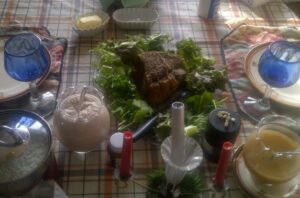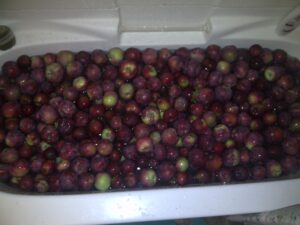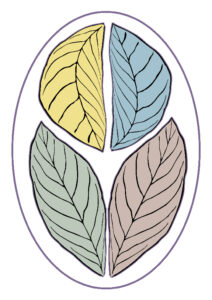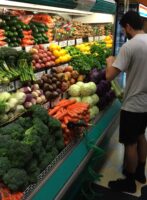Seven years ago when we began learning about Foraging (wildfood harvesting/wildcrafting), I would run across the occasional discrepancy between sources of info, some saying a given food was safe, others saying it wasn’t, and I would always insist on diving deeper till I found the source of the controversy! For Ponderosa Pine for example, the controversy settled around the fact it isn’t safe for pregnant or nursing women. Newsflash: Many foods in the grocery store are also not safe for pregnant or nursing women, but we don’t classify them as poisonous due to that fact. The next controversy was around Choke Cherry berries. Eventually that issue settled out to be a preparation issue. Eaten raw, too many can make you very ill. Sun-dry them or cook them for 5 min at a boil, and you denature the hydrocyanide in them, leaving the anthocyanidin behind to do it’s amazing healthy work we are used to from Almonds and other sources. Imagine if we had people claiming potatoes were poisonous because you couldn’t eat them raw?! There actually ARE book authors out there claiming Rhubarb is poisonous, go figure!
 Fast forward a few years, I’m now studying for my Natural Health Practitioner’s Diploma (just over 2 courses away now as of the time stamp on this article), and run across some authors who claim nitrates found in meat are carcinogenic and other authors saying we need nitrates for various purposes inside the human body. Finally one day I discovered the source of this controversy: speed and heat of cooking! It was preparation again! Meat cooked at lower temps for longer periods of time do not develop the carcinogenic issue as meats cooked quickly under charbroiling temperatures. Having said this, we much remember that prior to the invention of electrical and gas stoves and ovens, meat was ALWAYS cooked over a fire or in a stew pot, for millennia, without harsh repercussions! How did humans for all those years get away with that by today’s standards of cooking?! There are hundreds of plants out there that balance out this aspect of red meat, and many are actually best combined with red meat to synergistically benefit each other’s nutritional profiles.
Fast forward a few years, I’m now studying for my Natural Health Practitioner’s Diploma (just over 2 courses away now as of the time stamp on this article), and run across some authors who claim nitrates found in meat are carcinogenic and other authors saying we need nitrates for various purposes inside the human body. Finally one day I discovered the source of this controversy: speed and heat of cooking! It was preparation again! Meat cooked at lower temps for longer periods of time do not develop the carcinogenic issue as meats cooked quickly under charbroiling temperatures. Having said this, we much remember that prior to the invention of electrical and gas stoves and ovens, meat was ALWAYS cooked over a fire or in a stew pot, for millennia, without harsh repercussions! How did humans for all those years get away with that by today’s standards of cooking?! There are hundreds of plants out there that balance out this aspect of red meat, and many are actually best combined with red meat to synergistically benefit each other’s nutritional profiles.
 That discovery was just a few months ago. Today, another compound found in many plants, herbs and fruits has come to light with an equally head-scratching controversy around it. Salicylate, a naturally-occurring phenol best known for it’s use as a precursor to Aspirin and other pain killers, has been decried as dangerous and unsafe by some doctors and those who treat AD/ADHD. What isn’t said by these people, is that the long list of foods this compound is present in, also is responsible for anti-inflammatory, anti-oxidant, anti-bacterial, anti-carcinogenic, and many other benefits to the human body as well. The list is so long, that to completely knock it out would and according to one author, has, produced damaging nutritional deficiencies. There is one place you don’t want to get your salicylates, and it just so happens to be the same place you don’t want to get your nitrates: heavily-processed foods. You want these nutrients from whole foods!
That discovery was just a few months ago. Today, another compound found in many plants, herbs and fruits has come to light with an equally head-scratching controversy around it. Salicylate, a naturally-occurring phenol best known for it’s use as a precursor to Aspirin and other pain killers, has been decried as dangerous and unsafe by some doctors and those who treat AD/ADHD. What isn’t said by these people, is that the long list of foods this compound is present in, also is responsible for anti-inflammatory, anti-oxidant, anti-bacterial, anti-carcinogenic, and many other benefits to the human body as well. The list is so long, that to completely knock it out would and according to one author, has, produced damaging nutritional deficiencies. There is one place you don’t want to get your salicylates, and it just so happens to be the same place you don’t want to get your nitrates: heavily-processed foods. You want these nutrients from whole foods!
I tripped across a discussion on Salicylates due to a startling article Dr. Mercola wrote, discussing another doctor’s findings. This other doctor is a mortician responsible for embalming bodies, and to do that, he has to replace the body’s blood with embalming fluid. Since the COVID “vaxx” push began, this doctor’s discovery of strange clots has spread from not just his morgue, but to others as well. You can read that article here. Mercola-fibrous-clots-pdf
Mercola mentioned Salicylates as a way to prevent excessive blood clotting. Most people immediately think of over-the-counter medications for such a task, but it is far less damaging and far more beneficial, to get this and other anti-coagulant/anti-thrombotic compounds directly from food. One lady found a pdf listing many of the high-salicylate foods in a very negative presentation against them, but was asking how much she should eat.
This is my response (and part of my own list of salicylates in foods):

a) Compare your current pantry, fridge, spice cupboard, baking cupboard and freezer to this list.
b) How often do the items from a) that match up with this pdf, make it into various daily meals already in your home? If your answer is “rarely”, then ask yourself why, and what can be done about that why to make more use of what you already have available. Do note: eating a healthier regular diet often means making time to prepare meals at home, so for many, the why is often time and schedule related. Time management may need to be tweaked more creatively here.
c) If very few items in your home match what is on this list because you tend to eat out more often than not, then a food lifestyle shift is in order and this will impact both time management and household money management. The switch to preparing food at home often has a benefit on the pocketbook that suddenly reveals money where it wasn’t seen before. This “found money” can be used to build a healthy, enjoyable grocery list and make other bills easier to manage.
d) The foods on this list also have health benefits for other areas of your body due to also being anti-oxidant, anti-inflammatory, anti-bacterial, anti-viral, anti-fungal, and even anti-cancer. So you want something from this list two to three times per day, ideally in-season whenever possible to reduce distribution and supply chain issues. You can use the pumpkin spices sprinkled on oatmeal, in smoothies, added to non-irradiated cocoa blends (my daughter has a power blend she concocted!), stirred into hot water with several squirts of lemon and unpasteurized honey for example. Make your own dried fruit and nut trail mix, being sure to not add any of the candy and store-bought chocolate nastiness, just dried fruit and nuts, and perhaps shaken in a bag of your favourite herbs and spices picked from this list and some sea salt. Pumpkin seeds in the shell MUST be in that trail mix alongside cranberries and dried apple bits.
 As readers of this blog know, I have a budgeting course, as well as coaching offers that teach time management, household money management, and healthy grocery shopping, and soon (2.5 courses away), will have my Natural Health Practitioner’s Diploma and will be offering whole food natural health coaching from a Biblical perspective. (yes, you can still eat meat and dairy).
As readers of this blog know, I have a budgeting course, as well as coaching offers that teach time management, household money management, and healthy grocery shopping, and soon (2.5 courses away), will have my Natural Health Practitioner’s Diploma and will be offering whole food natural health coaching from a Biblical perspective. (yes, you can still eat meat and dairy).
If you would like help organizing your time and household finances to better manage your grocery bill and food preparation so you can feed your family better for less than the cost of eating out or ordering in, reach out to me! The new pathogenic landscape we find ourselves in demands that we make the necessary adjustments to ensure our households stay healthy.
(For previous articles written before April 2022 related to the intersection of faith and health, please visit my author website for the year 2021.)






